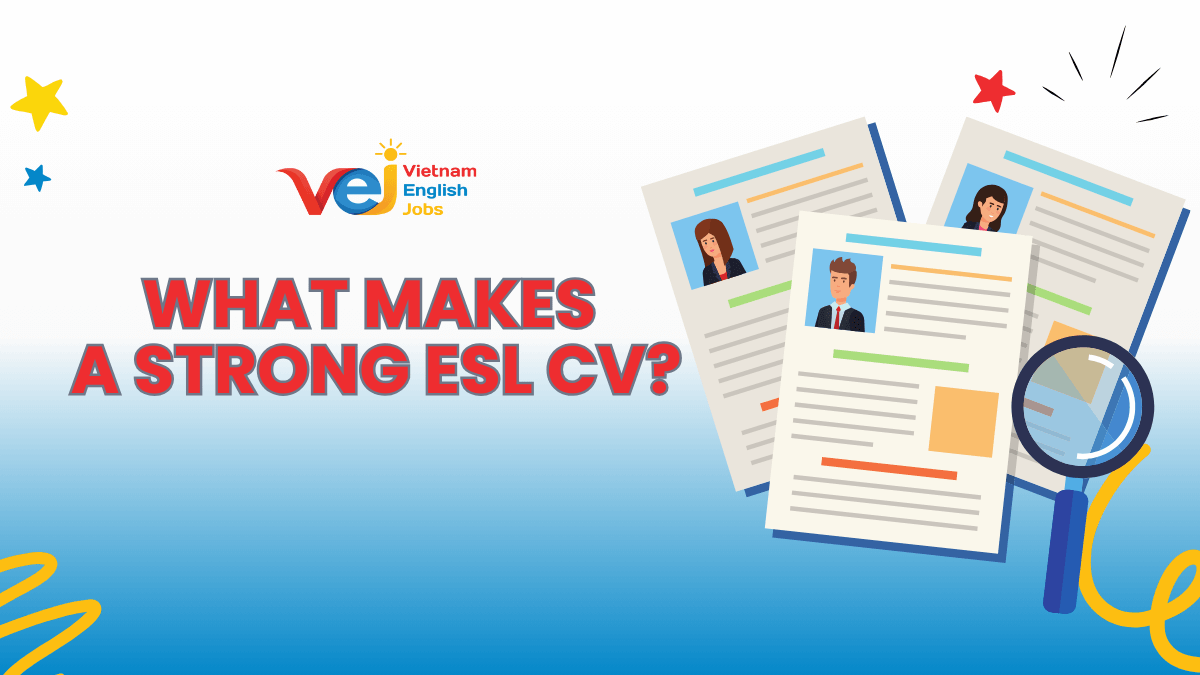How to Write a Strong CV and Cover Letter for Foreign ESL Teachers
When applying for an ESL teaching job abroad, especially in fast-growing markets like Vietnam, your CV and Cover Letter are often the first impression you make on a school or recruiter. A well-structured application not only highlights your qualifications but also demonstrates your professionalism and communication skills. In a competitive ESL job market, a polished CV and tailored Cover Letter can be the difference between getting noticed and being overlooked.
This guide will walk you through how to write a strong ESL CV and Cover Letter, with tips specific to teaching in Vietnam and other Asian countries.
1. Why Your ESL CV and Cover Letter Matter
- Showcase teaching skills clearly: Recruiters want to know your qualifications, experience, and adaptability.
- Stand out in a crowded field: Many schools receive dozens of applications weekly.
- Cultural expectations: In Vietnam, schools value teachers who appear reliable, organized, and professional.
- Highlight international readiness: Employers look for teachers who can adapt to a new culture and classroom environment.
2. How to Write an ESL Teacher CV

a. Personal Information
- Full name, nationality, contact details (email, phone, Zalo, WhatsApp).
- A professional photo (important in Vietnam).
- Current location and availability date.
b. Professional Summary
- A short paragraph (3–4 sentences) summarizing your teaching experience, strengths, and career goals.
- Example: “Dedicated ESL teacher with 3+ years of experience in Asia. Skilled at creating engaging lessons for young learners and exam preparation classes. Passionate about helping students build confidence in English communication.”
c. Education
- Bachelor’s degree (required in Vietnam for work permits).
- TEFL/TESOL/CELTA certification.
- Any additional qualifications (MA in Education, DELTA, etc.).
d. Teaching Experience
- List positions in reverse chronological order.
- Include school/organization name, country, dates, age group taught, and key responsibilities.
- Use bullet points to highlight achievements (e.g., “Increased student speaking participation by 40%”).
e. Skills & Competencies
- Classroom management
- Lesson planning & curriculum design
- Online teaching tools (Zoom, Google Classroom, etc.)
- Cross-cultural communication
f. Additional Information
- Languages spoken
- Volunteering or extracurricular teaching experience
- References (or “Available upon request”)
3. How to Write an ESL Cover Letter
Your Cover Letter should complement your CV, not repeat it. Keep it one page, professional, and tailored to the specific job.
*Structure of a Strong ESL Cover Letter
Greeting
- Address to the recruiter or “Dear Hiring Manager.”
Opening Paragraph
- State the position you’re applying for and show enthusiasm.
- Example: “I am excited to apply for the ESL teaching position at [School Name] in Ho Chi Minh City. With three years of experience teaching young learners and teens, I am confident I can contribute to your school’s mission of delivering high-quality English education.”
Body Paragraph(s)
- Highlight your most relevant qualifications and teaching experiences. Connect your skills with the needs of the school.
- Mention adaptability, creativity, and classroom results.
- Emphasize any Vietnam/Asia experience or cross-cultural teaching.
Closing Paragraph
- Reaffirm your interest and include availability.
- Example: “I look forward to the opportunity to bring energy and effective teaching strategies to your classrooms. I am available to start from [date] and would welcome the chance to discuss how I can support your students’ success.”
Signature
- “Sincerely, [Your Full Name]”
4. Common Mistakes to Avoid
- Using a generic CV without tailoring it to ESL jobs.
- Making the Cover Letter too long or too vague.
- Not including a professional photo (important in Vietnam).
- Forgetting to highlight TEFL/TESOL certification.
- Using casual language or poor formatting.
5. Tips for ESL Teachers Applying in Vietnam
- Professional photo required: Schools in Vietnam almost always request it.
- Mention flexibility: Employers value teachers willing to adapt to different age groups.
- Highlight exam prep skills: IELTS and TOEIC classes are in high demand.
- Emphasize reliability: Schools want long-term, committed teachers.
- Keep formatting clean: Simple fonts, bullet points, and consistent structure.
Crafting a strong CV and Cover Letter for ESL teaching is an essential step to securing your dream job in Vietnam. By showcasing your qualifications, tailoring your application to the role, and highlighting adaptability, you can stand out from the competition. Use this guide as a checklist, and you’ll be one step closer to landing your next ESL teaching position abroad.

















